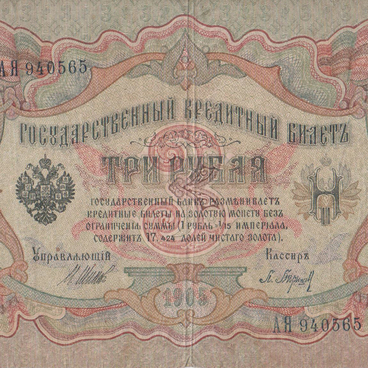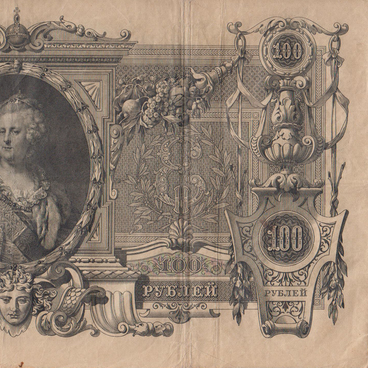The 1909 banknote of 25 rubles is one of the examples of the high standard of production of banknotes and securities in the Russian Empire. As well as on the majority of banknotes issued in Russia at the turn of the 20th century that had a high denomination, the twenty-five-ruble note bears the image of one of the representatives of the House of Romanov, in this case Alexander III, father of Emperor Nicholas II. This type of banknote was issued during the reign of Nicholas II.
In placing the portrait of Emperor Alexander III, the achievements of his reign were of course taken into account. First and foremost, this ruler is remembered by his nickname Peacemaker, which appeared due to the fact that under this monarch Russia did not wage a single major war. Furthermore, the Emperor is remembered for introducing major amendments to the reform policy of his father Alexander II, which are known as “counter-reforms”. They include a number of measures taken by the government designed to limit certain aspects of the Great Reforms, namely the restriction of the jurisdiction of the trial by jury, the introduction of the University Statute, which abolished the autonomy of universities, the weakening of the authority of local governments (zemstvo), the strengthening of some police measures after the murder of Emperor Alexander II, and the “cook’s children act” (the reduction of gymnasium education). In general, these activities of the Emperor are considered by historians from different angles: some see them as an attack on the liberal reforms of the previous government, others see them as necessary amendments designed to improve the system of administration and to prevent revolutionary forces from gaining a foothold in Russia. Nevertheless, during the reign of Nicholas II his father’s activity was assessed positively, so his image on the banknotes is not surprising.
The appearance of rulers’ portraits on Russian banknotes dates back to the middle of the 19th century. It was the period when the printing industry was undergoing significant development. The quality of banknotes was growing. No less important was the improvement of the system of protection of money from counterfeiting. All this resulted in the appearance of portraits on the banknotes of the tsarist Russia, as well as the more refined artistic component of the paper money.
When designing this banknote, the word “state” was placed off-center, which is unusual for other denominations.
In placing the portrait of Emperor Alexander III, the achievements of his reign were of course taken into account. First and foremost, this ruler is remembered by his nickname Peacemaker, which appeared due to the fact that under this monarch Russia did not wage a single major war. Furthermore, the Emperor is remembered for introducing major amendments to the reform policy of his father Alexander II, which are known as “counter-reforms”. They include a number of measures taken by the government designed to limit certain aspects of the Great Reforms, namely the restriction of the jurisdiction of the trial by jury, the introduction of the University Statute, which abolished the autonomy of universities, the weakening of the authority of local governments (zemstvo), the strengthening of some police measures after the murder of Emperor Alexander II, and the “cook’s children act” (the reduction of gymnasium education). In general, these activities of the Emperor are considered by historians from different angles: some see them as an attack on the liberal reforms of the previous government, others see them as necessary amendments designed to improve the system of administration and to prevent revolutionary forces from gaining a foothold in Russia. Nevertheless, during the reign of Nicholas II his father’s activity was assessed positively, so his image on the banknotes is not surprising.
The appearance of rulers’ portraits on Russian banknotes dates back to the middle of the 19th century. It was the period when the printing industry was undergoing significant development. The quality of banknotes was growing. No less important was the improvement of the system of protection of money from counterfeiting. All this resulted in the appearance of portraits on the banknotes of the tsarist Russia, as well as the more refined artistic component of the paper money.
When designing this banknote, the word “state” was placed off-center, which is unusual for other denominations.




